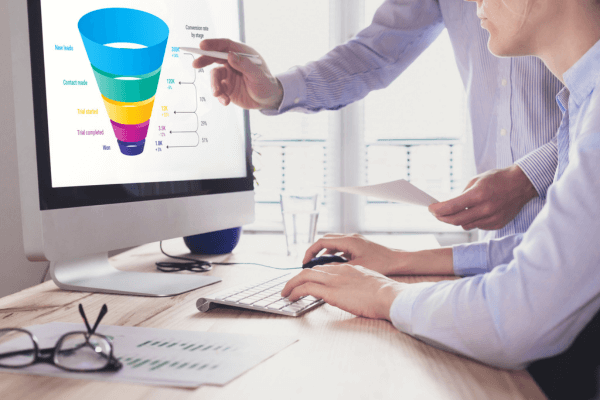
The aim of any business, whether physical or online, is to attract the attention of consumers to the virtues of your product/service so that they can eventually become customers.
Roughly speaking, what we've just summarised are the first and last stages of what is technically known as the "sales funnel".
After this first approach to the concept of a sales funnel, let's take a closer look at this process and try to explain what it is and how to create one for your business.
What is a Sales Funnel?
The term "Sales Funnel" refers to the entire process that begins with the marketing strategy, the aim of which is to promote your product or service to the general public. This process evolves as you engage with potential consumers, providing them with a service that captivates them, culminating in them making the purchase and paying for it.
This concept is fundamental to understanding how companies conduct their sales efforts, from the initial attraction to the actual conversion of consumers into satisfied customers.
Similar to what happens when you pour water through a funnel into a glass or bottle, the amount of water that goes into the mouth of the funnel is much greater than that which comes out into the glass.
This is what ends up happening with a sales funnel too, since of the large mass of consumers who become aware of your brand, only a small percentage end up buying what you have to sell.
It follows that the wider the "mouth" of the funnel, the greater the number of consumers you will be able to convert into customers. However, for this to be a reality, the whole process, which is made up of a series of intermediate stages, has to be finely tuned so that the potential customer doesn't abandon their shopping basket during the buying journey.
In addition to all this, the sales funnel is an important tool for improving the buying experience you offer your customers and for predicting new leads (consumers who are interested in your product/service).
Sales Funnel: Stages
For all this to be possible, however, you need to treat each stage of the sales funnel technique carefully so that each one fits the habits and needs of the leads you want to capture.
Stage 1: Prospecting (mouth of the funnel)
In this first stage, your business should endeavour to create a marketing and advertising strategy that will enable it to attract the attention of "prospects", i.e. consumers who, depending on how the information is presented to them, may or may not identify a need or problem they have to solve in the product/service offered.
To summarise, the prospecting stage is aimed at qualifying leads, i.e. capturing qualified leads through marketing strategies, taking them all the way through the funnel until they become sales-qualified leads (customers who end up buying your product/service).
Stage 2: Qualification
It won't do you any good to entice the customer into a buying journey in your physical or online shop if that journey is out of step with the target consumer's expectations and needs.
That's why, at the lead qualification stage, it's important that all the information (such as price, features, why it's the ideal solution for the problem in question, etc.) about the products/services you offer and the service you provide is as careful and personalised as possible so that the potential lead feels you're on the right track to satisfying their needs.
Stage 3: Completing the sale (end of the funnel)
If the middle phase of this sales funnel model goes as expected, the qualified lead will become a customer, in other words, they will make the purchase.
However, in order for the sale to go through, the entire checkout process must be as fluid and simple as possible through payment methods suited not only to consumer habits, but also to the nature of the business.
For example, in the case of an online business, REDUNIQ offers you two innovative solutions to reduce friction at the checkout and make it easier to realise sales: the REDUNIQ@Payments and REDUNIQ@E-Commerce.
While the first is a turnkey solution that will allow you to sell online with or without a website and accept it, securely, link payments by e-mail, SMS, WhatsApp, ATM reference, MB WAY or Visa and Mastercard. REDUNIQ@E-Commerce, aimed at professional online shops, offers the possibility of accepting online payments in Portugal with debit and credit cards, Visa and Mastercard, from customers all over the world, with no membership or monthly fees and total security.
If you are in charge of a physical shop, it is important to bear in mind that the weight of contactless in the turnover of Portuguese retailers already exceeds 50% (data from the Banco de Portugal Payment Systems Report), which will necessarily imply the offer of a payment terminal that accommodates this and other forms of payment that are a trend these days, such as the digital wallets and MB WAY.
These terminals include the TPA Android REDUNIQ Smart which, in addition to allowing a business to accept contactless payments with card, chip, MB WAY, Google Pay and Apple Pay, incorporates a set of management apps that help businesses and allow them to be fully mobile and digital and the REDUNIQ Softa solution of NFC payment Android that allows your business to accept payments quickly and easily via an App on your business's smartphone.
In the case of this solution, which turns your smartphone or tablet into a TPAYour business is immediately ready to start receiving payments. NFC payments, QR Code e Contactless.
Finally, we talk about REDUNIQ EasyThis is a solution where you pay a monthly amount tailored to your business, with no membership costs, loyalty period or minimum revenue, allowing you to have a free terminal and accept credit and debit card payments (Visa and Mastercard brands) via PIN, Contactless e MB WAY.
This is the right solution for businesses that have a relatively small turnover, sell seasonally, or don't want to worry about merchant service fees.


